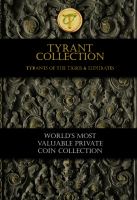

TYRANT COLLECTION
82
196
Sasanian Empire
Gold Light Dinar (4.14g, 18 mm), AD 457/9-484
Peroz (Firuz), Sasanian King, AD 457/9-484
Sunrise #950, SNS Type IIib/1c, Gobl Type III/1. Superb Extremely Fine.
Mint: WH (Veh Ardashir or Veh Andiyok Shapur).
Peroz was the eighteenth emperor of the Sasanian dynasty and was son of Yazdgird II. After a power
struggle with his brother, Peroz was able to seize the throne and become a legitimate successor to his
father. He is a celebrated monarch due to his compassion for his people during hardship and famine that
devastated the empire, draining its agricultural and financial resources. During the great famine of this
period, Peroz ordered all grain depots, public or private, to be open to all. Despite the anger of the nobil-
ity and the priesthood fover this unprecendented order, Peroz reinforced his decree declaring that those
who do not follow the decree will be put to death. As a result, the empire was saved and began slowly to
recover. His engagement with the Hephtalites to the east proved fatal. Peroz was killed along with most
of his troops in an ambush in the middle of his third campaign near the present city of Herat in Afghan-
istan. Prior to this final engagment, Peroz had fought the Hephtalites in two other campaigns, both of
which proved unsuccessful. His son and successor Kavad was left with the Hephtalites as a hostage to
guarantee an annual payment of ransom. A major achievement of Peroz was to stop the persecution of
Christians. His favorable attitude toward Christians might be a reason that his first crown has a uncanny
resemblance to that of his great grandfather Yazdgird I who also favored Christians. Peroz wears three
different crowns on his coinage, this portrait is his third and last crown with wings of victory. The reverse
shows the so called “Prayer” type which was instituted by his father Yazdgird II. Given his financial
difficulties, loss of resources and increased mintage due to wars and tribute to the Hephtalites, one can
observe debasement in both the gold and silver coins. In addition, the artistic quality of the coins be-
comes less skilled and less realistic. The rendition of the figures is more abstract. Peroz has been studied
substantially by Russian and German historians. Soviet-era historians considered Peroz an exceptional
man, leader and king, rising above typical oriental tyrants, due to his benevolence and courage in the
face of disaster. Several Persian historians such as al-Tabari and al-Biruni have recorded Peroz’s prayer
stating that he will give up his life for his people to in exchange for rain to end the famine. Folk tales
remember that after this prayer, rain began to fall.

















